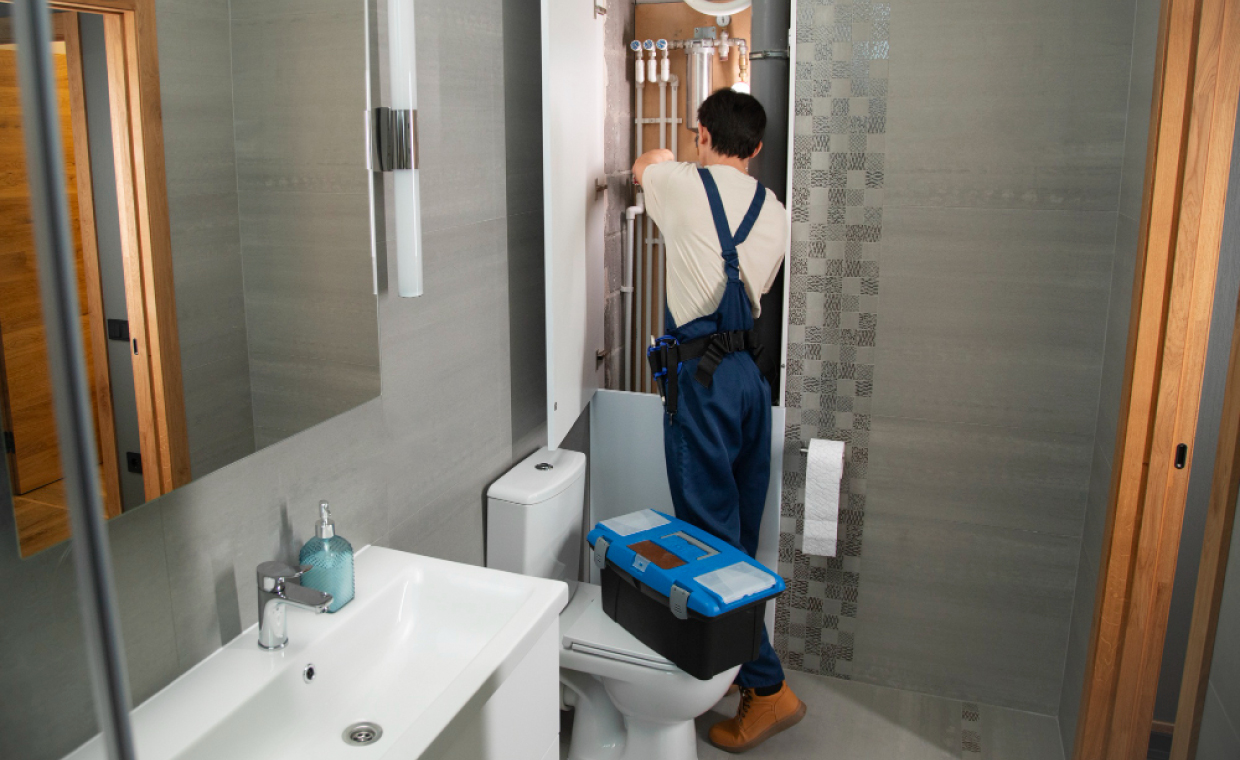
Drones. You’ve heard of them and seen them around, capturing stunning aerial footage and imagery. These drones have a wide range of applications, especially in the construction industry. Through this blog, Gharpedia covers the applications of drones in construction, along with their benefits, drawbacks, and different types.
Unmanned Aerial Vehicles (UAVs) or drones continue to revolutionise a wide range of industries and fields and have risen to prominence in the construction industry in the last few years. Along with drone technology, software powered by Artificial Intelligence (AI) has also been developed, which processes a drone’s raw visual data to produce maps of construction sites that are amazingly detailed.
Planners and architects in the building industry are increasingly turning to drones to keep tabs on progress and ensure it matches their vision and expectations. As a result of this information, developers and construction site businesses are more likely to maintain track of their inventory. Big-scale construction projects include a lot of activity spread over a large area. Visual cues are the only way to keep track of what’s happening at the construction site.
Drones can obtain the same visual data, which a surveyor working for a building company would gather in half a day by traveling on foot, in just 15 minutes. This means that data from a construction drone is more comprehensive and accurate due to the drone’s ability to gather visual video while in flight. It is now possible to map the entire location in various ways, with software specifically designed to process this type of imagery. Drone data has enormous potential for optimising operations for companies involved in constructing and managing massive infrastructures, such as highways, trains, bridges, dams, reservoirs, airports, industrial complexes, oil and gas activities, and power plants. This makes it perfect for construction applications.
Applications of Drones in Construction
Drones have been modified and remodelled to make them useful in rough conditions such as construction sites containing dirt, soil, cement, aggregates, and so on. Such enhancements are utilised as/in –
01. Surveys

It is possible to visualise a site quickly with drones because of their ability to map large areas of land. Drone-captured high-resolution aerial imagery effectively covers broad regions while offering a visual depiction of the site’s attributes. Overall, using drones for surveying and mapping has numerous advantages, including efficient data gathering, high accuracy, extensive visual information, and improved decision-making capabilities. Drone-based surveying and mapping give vital insights for design, engineering, and asset management processes, ultimately boosting construction project efficiency and quality.
02. Site Selection

One of the first tasks in building a structure is to select the appropriate site. It requires evaluating many potential sites to select the most appropriate location for the project. One of the key benefits of using drones for site selection and evaluation is their capacity to gather high-resolution aerial imagery. Drones with cameras may take detailed images and films of prospective sites from various angles and elevations. This imaging gives a thorough perspective of the site, allowing project managers, architects, and engineers to examine characteristics such as accessibility, proximity to transportation networks, and nearby infrastructure. By reviewing this data, stakeholders can assess whether the site satisfies the project’s logistical needs. They can detect any constraints or obstacles linked to site access, which might affect construction activities and the transfer of goods and equipment.
03. 3D Modeling

Drones can give data for 3D model maps of construction sites through accurate aerial monitoring and inspections. Using topography, precise site maps, such as contours and terrain, can be regularly acquired, updated, and collected as online maps for easy item inspection. The government can easily discover illegal construction using 3D Mapping, since it takes a fraction of the time and money to do so than traditional methods and offers them more control over projects.
04. Progress Monitoring

Progress monitoring is one of the most common applications of drones in construction. According to Choi et al., (Authors of the paper titled, “An Overview of Drone Applications in the Construction Industry”), surveys from various construction businesses to find out how drones were utilized in their construction projects were conducted, and they indicated that the most prevalent usage of drones was to capture progress images for monitoring of progress of construction. Developing regular flight paths over and around the construction site is essential for real-time progress monitoring as the project continues to exemplify the constructor’s vision. This information helps developers, stakeholders, and everyone involved in the construction process. Visitors to the company’s headquarters may make a monthly site visit to maintain tabs on progress toward major milestones.
Drone data can build maps, which are of great help for project managers for planning and monitoring progress. Project managers can minimise delays that could push a project’s budget above its budgetary limit. Using these maps, a manager can see if any equipment is missing or left in the wrong spot on the construction site. They can indicate areas that need further investigation and identify the reason work is taking longer than expected. This kind of information saves the manager from traveling the entire site to assess the state of various project components on foot. Using the data collected by the drone, the manager only needs to look at a map, zoom in to examine a specific area, and then pinpoint the problem.
05. Safety

Most construction firms prioritise worker safety. Manual measurements frequently need workers to scale unstable platforms and navigate hazardous terrain. Construction sites are high-energy, high-velocity settings with a plethora of constantly changing elements. Any elements such as power tools, heavy gear, building materials, or overlapping work crews can be deadly if ignored. It is now easier than ever to handle such dynamics because drones provide a bird’s-eye view, allowing project managers to quickly guarantee that conditions on the ground stay stable and safe. Site managers can fly a drone above the site to highlight to new site operatives the health and safety issues associated with moving vehicles, cranes, active excavation sites, and so on.
Advantages of Drones in Construction
It is evident from applications that drones serve a lot of benefits that are helping construction companies keep track of their progress. Some advantages of drones in construction are:
- It is possible to create spectacular time-lapse reels or cinematic experiences with footage from a drone. Using drones to tell a story is an important part of marketing, and they are proving to be potent instruments when in the right hands, especially in the construction market.

- Drones help site managers monitor progress and make informed decisions based on the most up-to-date data and comprehensive site maps that are more accurate than plans or partial data.
- A transport construction project can benefit from drones at every stage, from preconstruction to operations and maintenance. Real-time data sharing and seamless resource and stakeholder integration are hallmarks of this system.
- When a project is built on a poor foundation, it is nearly impossible to determine who or where the error occurred. In construction, drone data provides clear, accurate, and easily retrievable documentation.
- Drones may watch building sites while the work is going on, looking for risky situations and spotting problems before they become a danger to life.
Disadvantages of Drones in Construction
Besides having numerous advantages, drones have disadvantages, such as:
- Some drones necessitate piloting abilities, while others require geospatial expertise to process data.

- The ultimate scope and deliverable requirements significantly impact the drone’s cost (accuracy, resolution, flying time, swath, file type, etc.). Costs range from $2,500 to $15,000 for a professional-grade industrial drone equipped with a 20-megapixel camera.
- Each country has its own regulations and restrictions on the use of drones in metropolitan areas and restricted airspace. Before using a drone, sometimes permission is required from local authorities, which can be time consuming.
Types of Drones Used in Construction
Not all drones are of the same type, as each has a different role. The common types of drones used in construction are as follows:
Multirotor Drones

Professional pilots can take off like helicopters and are extremely stable and manoeuvrable, thanks to their multirotor design. There has been a tremendous improvement in the artificial intelligence software used to control drones, which means that even the most unskilled pilots can learn to fly within minutes.
Fixed Wind Drones

In order to fly like a normal plane, fixed-wing drones use a low-pressure system on top of the wing to move through the air and create lift like an airplane. To avoid falling out of the sky, they either follow a pre-programmed route with pre-determined waypoints or an experienced fixed-wing drone pilot handles them.
Helicopter Drones

Helicopter drones have only one primary rotor and appear like helicopters. Multirotor drones create a lot of turbulence, making a single rotor on top much more efficient. In addition to longer flying periods, they require less energy per flight.
Fixed-wind Hybrid Drones

Combining a drone’s advantages with the stability and manoeuvrability of a motor-based device is possible. Control sensors for these devices are becoming more efficient and cost-effective as they become less frequent. Because of the technical characteristics that these types of drones often have, they tend to be only suitable for extremely specific applications and are quite expensive.
What is the Future of Drones in Construction?

Drones powered by AI software can play a significant role in the construction industry’s technology commercialisation. Cutting-edge technology is enabling the drone industry to provide a quantum leap in useful data, reducing costs and enhancing safety while maximising performance. It is currently possible for drones to save costs and time, as well as reduce risk and labour, while simultaneously boosting workflow and accuracy. The construction process will become even more efficient by adopting these technologies on a broad scale in the future. It’s reasonable to conclude that commercial drones are here to stay as long as the technology can pass government aviation and zoning restrictions.
Conclusion
Drones are incredibly useful instruments that may improve safety, raise productivity, and even save expenses. Drones in the construction business are becoming increasingly popular, so workers must become aware of the new technology and make an informed decision about whether they want them flying over their construction sites.
Apart from drones, different robots have made their presence felt in construction. Know more about robotics in construction:
From Automation to Advancement: The Power of Construction Robotics






























